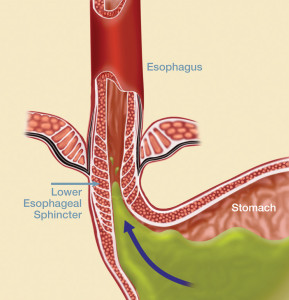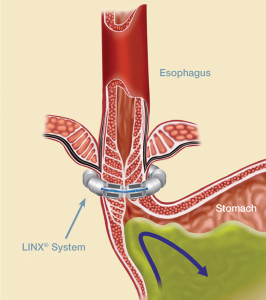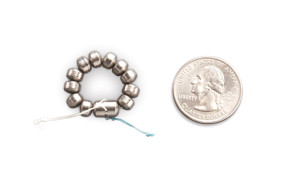LINX® is designed to augment the weak lower esophageal sphincter (LES) to help prevent reflux.
Gastroesophageal Reflux Disease (GERD) is a chronic, often progressive disease caused by a weak lower esophageal sphincter (LES) that allows acid and bile to reflux, or flow back, from the stomach into the esophagus.
The LES is a muscle at the junction of the esophagus and stomach that functions as the body’s natural barrier to reflux. The LES acts as like a valve, allowing food and liquid to pass through to the stomach. Normally, the LES resists opening to gastric pressures to prevent reflux. In people with GERD, the LES is weak and allows acid and bile to reflux from the stomach into the esophagus, often causing injury to the lining of the esophagus and symptoms such as heartburn, chest pain, regurgitation, sore throat and cough (see Figure 1).
LINX® is a small, flexible band of magnets enclosed titanium beads. The beads are connected by titanium wires. The magnetic attraction between the beads is designed to help keep the weak LES closed to prevent reflux (see Figure 2). Swallowing forces temporarily break the magnetic bond, allowing food and liquid to pass into the stomach. Magnetic attraction closes the LES after swallowing to reinforce the body’s natural barrier to reflux.

Figure 1: In people with GERD, the lower esophageal sphincter (LES) is weak, allowing acid and bile to reflux from the stomach into the esophagus.

Figure 2: LINX® is designed to keep the weak LES closed to prevent reflux.
How is LINX® Implanted?
LINX® is placed around the esophagus just above the stomach using a common, minimally invasive, surgical technique called laparoscopy. Patients are placed under general anesthesia during the procedure, which is generally completed in less than one hour. Once implanted, the device will begin working immediately.

The LINX System is a small, flexible band of
magnets enclosed in titanium beads.
View our recent press release about this new procedure at UC Health.
